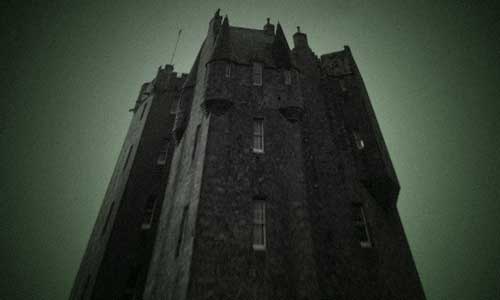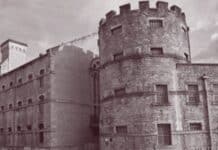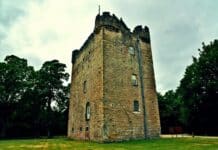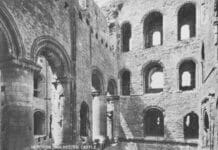Castle Stuart in the Scottish Highlands has many ghosts and other mysteries, says FRANCES ABBOT
As I write, the Scottish Open has just come to the end of its second year on the golf course at Castle Stuart in the Highlands. I watched the players on the television news play their putts, birdies and bogeys on the scenic greens by the shore of the Moray Firth, and I wondered if the golfers ever looked behind them at the towering mass of the castle glowering over their shoulders. Did they ever feel a frisson of fear? They should have, for Castle Stuart has been haunted for 300 years.
For me Castle Stuart was just a name on a signboard passed on the road to the airport to pick up visitors a few times a year. Set back as it is from the winding road, there is nothing to be seen of the castle apart from a glimpse of its dark turrets rising above the trees.
It remained a tantalising mystery until the day I was browsing the local history shelves of the reference library and discovered a small book with a truly lurid front cover picturing the castle in reds, orange and black, and a title in white screaming the words THE MYSTERY OF CASTLE STUART in ghostly graphics. I pounced on it.
The mystery of Castle Stuart
It didn’t disappoint. It was written in 1930 by a local man who had heard the tale as it had been handed down orally over the generations. A mysterious ghostly tale it is, but the part that grips the imagination is the foreword written by the owner of the castle when, in 1996, he was making it habitable after many years of neglect.
It seems that in 1798 a great storm rampaged up the Moray Firth tearing off the roof of the East Tower. Never repaired, that part of the castle had been sealed off from the rest for 300 years until, during the restoration, the intrepid owner climbed a ladder to look at roof beams after his workmen had left for the night. On the wall he noticed a difference in the plaster work and, curious to find out if this was the sealed doorway, he fetched a lamp from his car, a hammer and chisel, and set to.
His efforts uncovered a stone step, likely part of a broken stairwell, and beyond that a wall of solid stone. Using his chisel he patiently prised away at this wall until he had made a small hole, and at this point probably wished he had left well alone for, from the hole he created, there came forth a shriek to shatter the ear drums, followed by the sound of wailing, and finally a voice, low but forceful. The voice said NO!
Whatever escaped from the hole he had made hadn’t finished with our man yet. He reports that air turned foul and a feeling of hostility surrounded him. He tried to return from the beam to the ladder but was thrown back by a blow to the chest. Was it a fist- an invisible fist? As soon as he recovered his balance, he made a hasty exit, sped on his way by another piercing scream.
Appetite whetted? Ready for the ghosts? On to the story.
The castle belonged to the Royal House of Stuart, gifted by the Stuart King James V in the early seventeenth century. It was the home of the Earls of Moray and the tale begins when, a hundred years later, the young earl on inheriting came up from London with his household to occupy his new home and left, servants and all, after living there only a week. Two subsequent attempts to rent out the castle had the same result. No one ever lasted longer than a week.
The earl consulted his factor on how to get rid of the ghosts he was sure inhabited the place, for his servants had reported footsteps on the stairs at midnight, screams and a sighting of a headless highlander in full highland dress. The factor scoffed. Though living in an age when superstition was rife, he had no belief in ghosts. He in turn consulted the minister of the parish who came up with a plan.
The minister would engage four men to stay one night each in the room where the sightings took place. At the end of the period the four would meet and relate their experiences. He would be the first of the four and the others would be encouraged by a reward of £20.
By bribery, trickery and guile he got three more, the church elder, the local shoemaker and a giant of a man called Rob Angus who, despite being a poacher and a maker of illicit whisky, was a good-natured, friendly fellow afraid of nothing.
The minister was the first to be locked in the room near the top of the castle, where he found a peat fire, two easy chairs, a table with a brass lamp, a mirror and a bookcase. All very civilised, and with the heat from the fire he fell asleep. Next morning he told the curious that he had dreamt that at midnight the door opened. A man in highland dress stepped in. He sat in the chair opposite, sighed and questioned the minister as to why he was there. The minister was quite satisfied that, apart from his strange dream, nothing untoward happened that night.
The church elder was next to spend the night in the locked room. He was awake and reading his bible when the highlander sat down. What set him saying his prayers was the reflection in the mirror of a human skull grinning at him. When the skull vanished, the highlander rose, drew his dagger and came towards the poor shivering elder, who promptly fainted. So ended the second night.
The shoemaker didn’t see the highlander. Oh no. At midnight it was a tall man with cloven hooves that caused him to fall unconscious to the floor to be discovered there next morning by the officer of the tower. And so we come to the last night. Tension building?
It was now the turn of Rob Angus, who sat with his illicit whisky convivially drinking and blethering with the officer until the man left to lock him in. When the officer returned next morning, he was astonished to see there was no sign of Rob. Not only that, the room was wrecked, furniture overturned and broken as if a violent fight had taken place. Most strange of all was the missing window. There was no glass, there was no window frame. There were no clues to say whether fearless Rob Angus had taken the only way out to get away from whatever was in the room with him, or whether he was pushed out of the window.
Ah, but there was a witness to add an appropriately horrific end to the tale, an independent witness, who, because he was a stranger, had not heard anything about the vigils over the past four nights. This was a passing drover given permission for his sheep to spend the night in the field around the castle. Checking on his flock by the light of a full moon he spied a light in the window of the castle, heard the noise of a struggle and screams, then the sight of a man being thrown with force from the window, and the face that appeared in that empty space was the hideous face of the Devil himself.
A satisfactory ending to a gloriously spooky story.
I wonder if the owner or guests of the luxury accommodation Castle Stuart has become ever bump in to the melancholy highlander in the hall or on the stairs, or hear the screams of Rob Angus reverberating around the thick stone walls, or (I like this idea) whether Auld Nick, as the Devil is called in Scotland, has fun misdirecting the shots of the golfers trying to get out of the rough.
FRANCES ABBOT has gone from writing plays to be performed by children and arts/community groups to writing short stories and is now writing a crime novel. You can follow her on twitter @AbbotFabbot.








